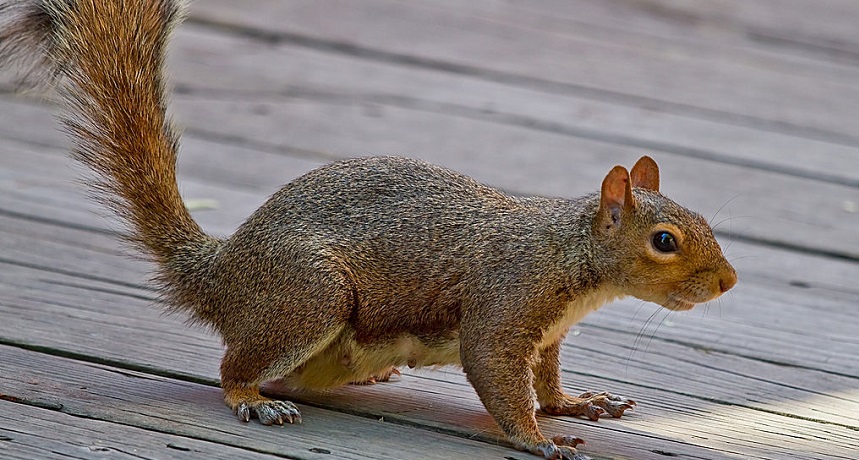Stalking squirrels for science
A new study about squirrels uncovers the science in your backyard

An eastern gray squirrel, Sciurus carolinensis. This urban resident knows when to fear pedestrians, and when they can be safely ignored.
Greg Hume/Wikimedia Commons.
When Bill Bateman was visiting family in New York, he noticed squirrels everywhere. It gave him a testable idea — one that resulted in a published scientific paper. All it took was paying close attention to urban wildlife.
His squirrel study showed that our furry friends in cities are very aware of people. They know what we’re doing and whether we’re a threat to them. His data show squirrels monitor the people around them to succeed in their environment. And it shows that conducting a scientific project doesn’t have to rely on fancy lab equipment.
Bateman is an ecologist at Curtin University in Perth, Australia. Every year, he visits family in an area of New York City — Manhattan — that is full of apartment buildings and people. Their neighborhood, Stuyvesant Town-Peter Cooper Village, is also home to plenty of squirrels. The eastern gray squirrel, Sciurus carolinensis, does just fine in such densely populated urban neighborhoods. It’s not a picky eater, and will chomp away on nuts, birdseed or that bagel you threw away. In his family’s neighborhood, Bateman estimated that there were more than 800 gray squirrels in about 32 hectares (80 acres), or around 60 U.S. football fields worth of space.
But Bateman noticed that even though the squirrels lived in the city, “the animals still make sure people don’t get too close.” In most cases, the squirrels easily ignore people walking by, but make a run for it when confronted by dogs who want to eat them, or toddlers who want to pet the furry critter. This understanding of “threat” allows these furry neighbors to forage for food even in the midst of crowds.
Every time Bateman returned to Manhattan, he caught himself squirrel watching. The rodents’ behavior fascinated him. At some point, the scientist realized he could conduct an experiment to “find out how they deal with living with humans.”
Bateman hypothesized that squirrels use detailed cues from people to know when to run and when to keep eating. He suspected the squirrels know what behaviors are normal for people (say, walking on the sidewalk). They would likely run only when a person breaks from that pattern (such as when a toddler makes a break for the squirrel), or when someone looks at them, indicating that they’d like to play squirrel tag.
To test this, Bateman had to do some squirrel hunting. Each morning he looked for squirrels. When he saw one, he would walk toward it in one of four different ways:
1. On the sidewalk, but not looking directly at the squirrel.
2. On the sidewalk, but staring hard at the furry dude.
3. Leaving the sidewalk, without directly looking at it.
4. Leaving the sidewalk and staring intently at it.
In each case, the scientist kept to a slow walking pace. To measure how close he got to the squirrel, he dropped colored pen lids as he walked. Afterward, he could measure the path they marked. He also held a timer to see how long it took before the squirrel made a run for it.
Squirrels “can tell if a human is looking at them,” or if a person behaves in an unusual way, Bateman found. Squirrels were 40 percent more likely to scoot if Bateman focused his attention on them. And 90 percent of the squirrels leapt away if the scientist left the sidewalk to stalk them across the grass. “They don’t get scared by humans all the time,” he explains. But they always seem to pay close attention to what people do. Bateman published his results June 12 in the Journal of Zoology.
This focus on how people behave, Bateman says, helps the animals forage as long as possible, while still avoiding people who might pose a threat. “It’s their ability to use these tiny cues”— such as whether a human is on the sidewalk, or looking at a squirrel — that allows the animals to be such successful city dwellers.
But Bateman’s study shows something else as well. It shows that science is waiting, right outside your door. He started by observing the world around him, then coming up with a hypothesis. To test that idea, he then performed an experiment that allowed him to measure his findings.
The next time you are at home, look around. What do you see? Does it give you any ideas? Maybe there are birds that behave oddly or plants that grow better in one place than another. A chance to do scientific research can be as close as your backyard.
Follow Eureka! Lab on Twitter
Power Words
ecology A branch of biology that deals with the relations of organisms to one another and to their physical surroundings. A scientist who works in this field is called an ecologist.
forage To search for something, especially food.
hypothesis A proposed explanation for a phenomenon. In science, a hypothesis is an idea that hasn’t yet been rigorously tested. Once a hypothesis has been extensively tested and is generally accepted to be the accurate explanation for an observation, it becomes a scientific theory. Ideas that are based on a hypothesis are referred to as hypothetical.







